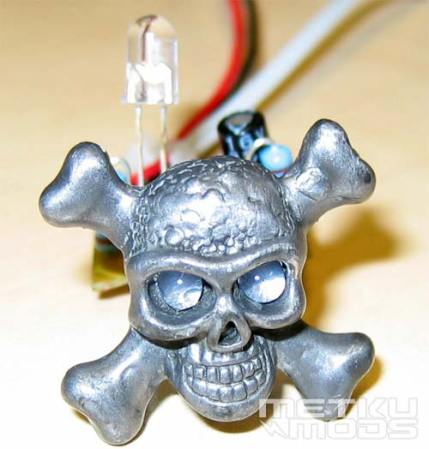
We almost skimmed right past this spooky HDD activity light thinking it was just another set of LEDs wired to the motherboard. However, they explained right off that they didn’t want just another blinking light on their case. They wanted it to change its intensity smoothly based on hard drive activity. While there are a million ways this could have been over engineered, we think they did a pretty good job of simplifying the circuit. The bill of materials is pretty much just a handful of resistors, LEDs, an opto isolator, and a capacitor. The effect, is quite nice and can be seen in the video after the break.
[youtube=http://www.youtube.com/watch?v=3sRWlocb_s8]
[via Hacked Gadgets]















Arrghhhh the terror of it all! Can I come out from behind my chair yet?
You could wire it up to the LED’s in the front case fan.
Pretty cool though
thats the first time I have seen somebody use the mysterious third contact of the optocoupler-transistor.
Why does it actually produce this result?!
This mod (not hack) is extremely old. HAD makes me sad.
No offence, but the topic made me laugh, “just in time for halloween”. The article was posted at Metku.net 2nd of October 2004…
http://metku.net/index.html?sect=view&path=mods/hdd_eyez/index_eng
Get a Hotwheels car, one with lots of clear plastic (colored plastic is cooler), and drill a small hole into it. Stick a Christmas light inside it and pop it on the tree. It glows a nice color and looks badass.
An opto isolator was NOT needed for this. You don’t need isolation from the HDD activity line when it is only 5V! I understand why they did it – they didn’t want the capacitor to discharge when the HDD activity light went low. A simpler way to do it would be to have the HDD light directly turn on the base of an NPN transistor, which connects the capacitor/LED’s to 5V. Thus while the HDD activity pulse is high the capacitor will charge and the LED’s will light, and when the HDD line goes low the transistor turns off and the voltage on the cap is discharged through the LED’s, giving the same dimming effect. No opto needed.
correnction, NPN wouldn’t work in this case, but you could still do it without an opto
ugh, I need to stop second guessing myself, I was right the first time:
Collector of NPN goes to 5V. Emitter goes to postive on cap and the other end of the cap is connected to ground. Emitter is also connected to the resistors/LEDs, which then go to ground. The only reason you wouldn’t be able to do this is if they didn’t have access to a 5V line, but that should be easily available within a short distance of the HDD activity line.
You don’t even need the transistor – much less the optocouple. Just the LED(s), current resistor(s), the cap for diminishing effect and a diode to prevent the caps from discharging back into the HDD/mobo.
I think it’s in HAD just because of the skull… Anyway… this is great for internet pirates who are constantly downloading.
Very cool.
I don’t care how OLD it is. I have never seen it before and I would guess that most people looging in here haven’t seen it either. It looks neat and is a cool hardwear mod. Please stop complaining about the content of the blog you subscribe to.
I’m glad that people still find this interesting. :)
I personally try to use an opto when interfacing hardware like this. I only needed a digital signal transferred to a one circuit to another and wanted to keep them electrically separated. I could then run the end-circuit with the voltages that I wanted.
Happy hacking! :)
@Erik
Totally right, that’s the simplest explanation of all, and way easier to implement. Using an opto is nuts
Very nicely done, and a nice simple little circuit.
@Japala
Love your Metku.net, keep up the good work (MOAR MODS <3 )
@Japala
I understand you want to isolate your motherboard from the circuit, but an optoisolator is absolutely pointless if you’re using a common ground anyway. If you wanted to connect it to a separate power supply it makes sense, but your setup isn’t actually isolated at all.
it looks good. of course i would have just used the pre-existing HDDLED wires and wired up 1 LED and maybe some of that plastic stuff they use to carry the LED light elsewhere, which you can find in: satellite boxes, monitors, old computers.. hot glue might even do the trick. and those skinny rectangle LEDs you can find in places like the ethernet port of a motherboard, or other parts of old computers/monitors/etc. but this guy actually built a little circuit to do the job, whereas i would have taken the quick/lazy route.
Am I right in thinking you can salvage optoisolators from old PCI modem cards and broken laptops?
@Haku yep, modems and power supplies especially. Basically anything with both a low voltage and high voltage circuit in the same circuit. They are usually the obvious 4-pin white/tan DIPs, and may even have a silk-screened line going directly underneath the middle of the IC instead of around like everything else (denoting the segregated sections of the board)
this is as old as computers
I think this is what Eric meant
http://imgur.com/bdX6X
This is old but I love Metku Mods, so I forgive you.